
Frere Hall
Completed in 1863, Frere Hall, located between Abdullah Haroon Road and Fatima Jinnah Road, was originally intended to function as Karachi’s town hall, but now serves as a library and exhibition space. One of the finest architectural endeavors of the early British Colonial era in the city, this iconic structure is also known for the mural that occupies the interior ceiling, painted by the inimitable Sadequain. Along with the mural which remains incomplete after his death in 1987, several of the artist’s works reside in the hall, causing for it to be named Galerie Sadequain.
Participating Artists:
Ivan Lam
Born in 1975 in Kuala Lumpur (Malaysia)
Lives and works in Kuala Lumpur (Malaysia)
Ivan Lam graduated with a BA in Fine Art (majoring in painting) from the Maine College of Art USA in 1998 and returned to Malaysia to begin his career as a fine artist. Lam’s works span a variety of mediums and ideas inspired by popular culture, autobiography, current affairs and every day vistas. The concept of duality has been continuously present throughout his journey as an artist, with contrasts and opposites always playing a role in his works. In 2015, Wei-Ling Contemporary held a comprehensive survey documenting twenty years of the artist’s practice, entitled Ivan Lam: TWENTY. In 2013, Lam participated in Art Basel Hong Kong with the exhibition COMA – Compendium of Malaysian Art. And in 2016, Lam participated in Volta New York.
For his video for KB17, Lam references a workshop he conducted with students earlier in the year at the NJV Building, one of the principal sites of KB17. He states: “The artwork that I will be showing is the last of its many incarnations--from the workshop with the NJV students, to the building of a three dimensional color wheel, and now to this video installation. The video consists of moving images of all the artworks the students did during the workshop, along with some hidden footage blended in. It's a pensive work; the color dots lull in a maze of quiet discontentment and beauty.”
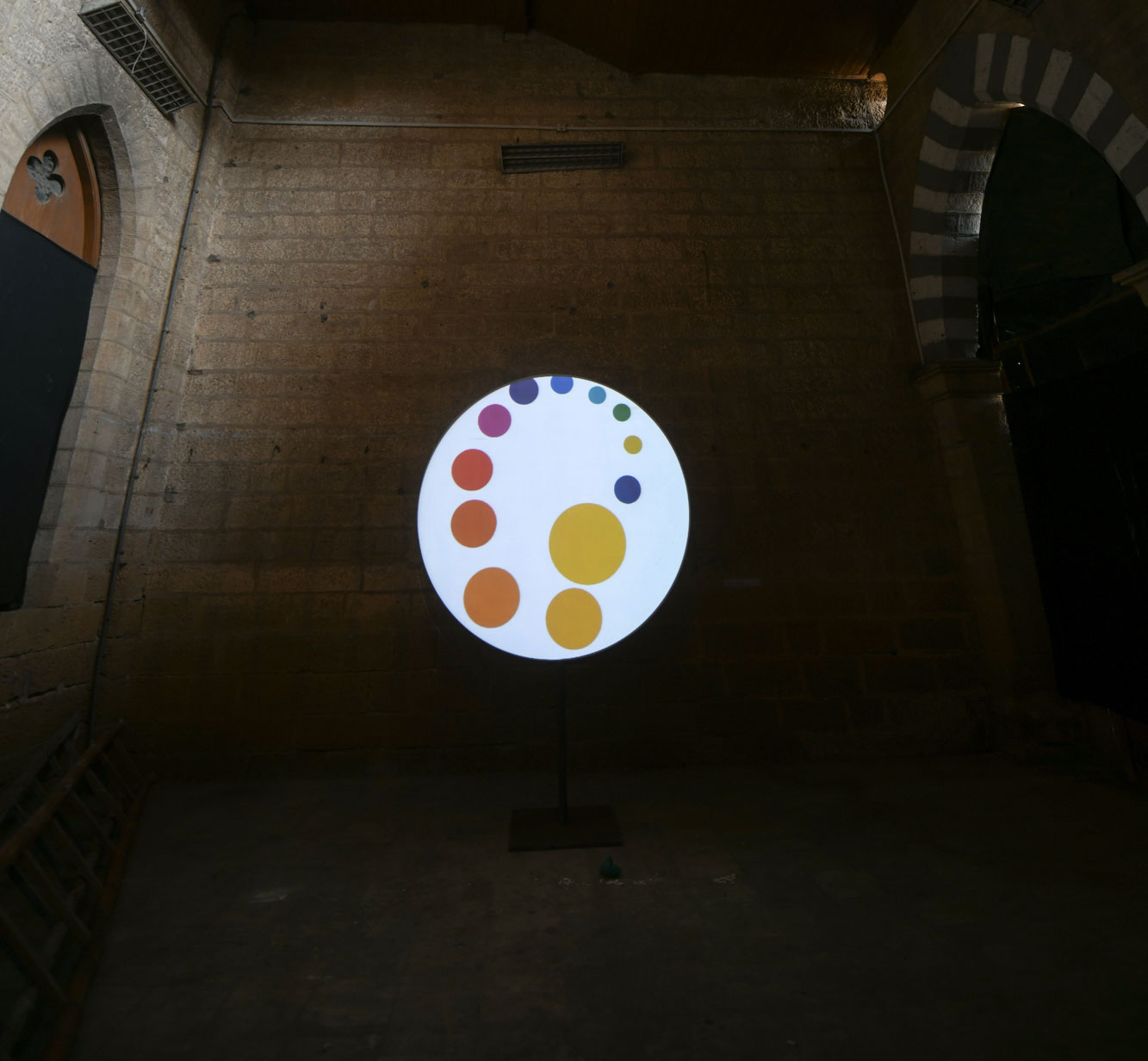
You Said You’ll Never Leave, 2017.
Single channel video, 100 min. (looped)
Courtesy the artist and Wei-Ling Gallery, Kuala Lumpur
Bani Abidi
Born in 1971 in Karachi (Pakistan)
Lives and works in Berlin (Germany)
Bani Abidi uses video and photography to comment upon politics and culture, often through humorous and absurd vignettes. Her work has been exhibited widely in solo and group shows internationally. Solo shows have taken place at Dallas Contemporary, Dallas, Texas, Kunstverein Arnsberg, The Baltic, Gateshead, Experimenter, Kolkata, Green Cardamom, London, amongst others. Select group shows include the 8th Berlin Biennial for Contemporary Art, 2014; In Plain Sight, Smack Mellon, New York, 2014; Lines of Control, Nasher Museum, Duke University, 2013; No Country, Guggenheim Museum, New York, 2013; dOCUMENTA 13, 2012; Kochi Muziris Biennial, 2012; Blockbuster: Cinema for Exhibitions, Mexico, 2011; Where Three Dreams Cross, Whitechapel Art Gallery, London, 2010; Xth Lyon Biennale, Lyon, France, 2009; 7th Gwangju Biennale, Kwangju, South Korea, 2008; Thermocline of Art: New Asian Waves, ZKM, Karlsruhe, Germany, 2007; Singapore Biennale, Singapore, 2006; SubContingent: The South Asian Sub Continent in Contemporary Art, Fondazione Sandretto Re Rebaudengo, Turin, Italy, 2006; Contemporary Commonwealth, National Gallery of Victoria, Australia, 2006; and 3rd Fukuoka Asian Art Triennale, Fukuoka, Japan, 2005, amongst several others. Abidi’s work is in collections of the Museum of Modern Art, New York, Guggenheim Museum, New York, The British Museum, TATE Modern, The Spencer Museum of Art, The Fukuoka Asian Art Museum, The Burger Collection, Devi Arts Foundation, and Marguelies Collection amongst several other private and public collections. She was artist in Residence at DAAD Artists Residency, Berlin in 2011/2012.
Bani Abidi writes of her video installation on view at KB17: “The city has come to a halt. A state dignitary is about to arrive. Traffic is blocked to make way for the unhampered movement of four luxury vehicles. School children with crumpled paper flags in hand wait patiently to wave at the passing motorcade. An anxious reception committee of officious bureaucrats paces up and down a red carpet.”

RESERVED, 2006.
Double channel video installation, 9:00 min.
Commissioned by the Singapore National Arts Council for the Singapore Biennale 2006.
Courtesy the artist
Anum Jamal
Born in 1988 in Karachi (Pakistan)
Lives and works in Karachi (Pakistan)
Anum Jamal received her Bachelor’s in Fine Art from the Indus Valley School of Art and Architecture, Karachi in 2012 and was the recipient of the Zahoor ul Akhlaq Award for Best Drawing Portfolio, after which she received her Master’s in Contemporary Art Practices from Coventry University, UK in 2015, both degrees with distinctions. She has had solo shows at Althorpe Galleries, UK and Koel Gallery, Karachi. Her works have also been showcased in several group shows in the UK, US, Italy and Pakistan, most notably The Young Masters Art Exhibition in Cynthia Corbett Gallery (UK) and The Salon Presents ETA (UK). She currently teaches at the Indus Valley School of Art and Architecture as a Senior Lecturer in the Liberal Arts Department.
Anum Jamal writes of her work created for KB17: “Repetitive schedules, rules, laws and regulations, jobs, and security measures dog our everyday lives. The uncertain political situation makes us yearn for the mundane.” Locus questions the notions of tedium and monotony and whether they are a luxury or a struggle. The work is based on the physiognomic profiles of the strangers the artist comes across daily and how they impact the architecture of our lives. Jamal believes that each of these strangers has something unique that needs to be highlighted.

Locus, 2017.
Digital drawing, graphite and colour pencil on paper and foam-board
183 x 183 x 152 cm.
Courtesy the artist
Arsalan Nasir
Born in 1990 in Karachi (Pakistan)
Lives and works in Karachi (Pakistan)
Arsalan Nasir obtained his Master’s Degree in Art & Design Studies, from Beaconhouse National University, Lahore, in 2017 where he received the UMMESA South Asia Scholarship Award. He received his BFA (with Distinction) from the University of Karachi in 2013. He has exhibited his work in several group exhibitions in Pakistan, the most recent of which was at the Dutch Embassy in Islamabad. He has also participated in several artist residencies, including: the first Sanat Residency, Karachi; and the Social Sculpture Residency at Vasl, Karachi, in collaboration with Heinrich Boll Stiftung. He is currently working as a Scale Model Artist at KSEW Pakistan Navy. A multi-disciplinary artist, Nasir’s technical practice spans drawing, painting, sculpture, printmaking, installation and new media, and his energetic drive to explore new mediums has resulted in his development of interactive technologies within his artwork. The basis of his artistic practice is an exploration of memory, and relaying of memories through everyday stories. He is especially interested in the concept of collective recollections, and the role of imagination in the formation of the personal narratives that constitute our memories, which are subsequently passed down as edifying experiences.
Nasir’s sound installation for the Karachi Biennale 2017, Absent/Present, comprising of a circle of schoolchildren’s backpacks, is an investigation into the way in which we embed memories in an existing space. The project explores the nostalgia elicited by re-encountering objects and spaces of prior significance, which in turn triggers memories, personal narratives and specific experiences, creating an internal dialogue between recollection and the actuality of the past. Thus, the school bags, emitting sounds when the motion sensors within are triggered, provide a visual and sonic representation of the capacity of a space or an object provoke a collective recollection, mediating a dialogue between the past, individual narratives, shared experiences and the subjectivity of memories.
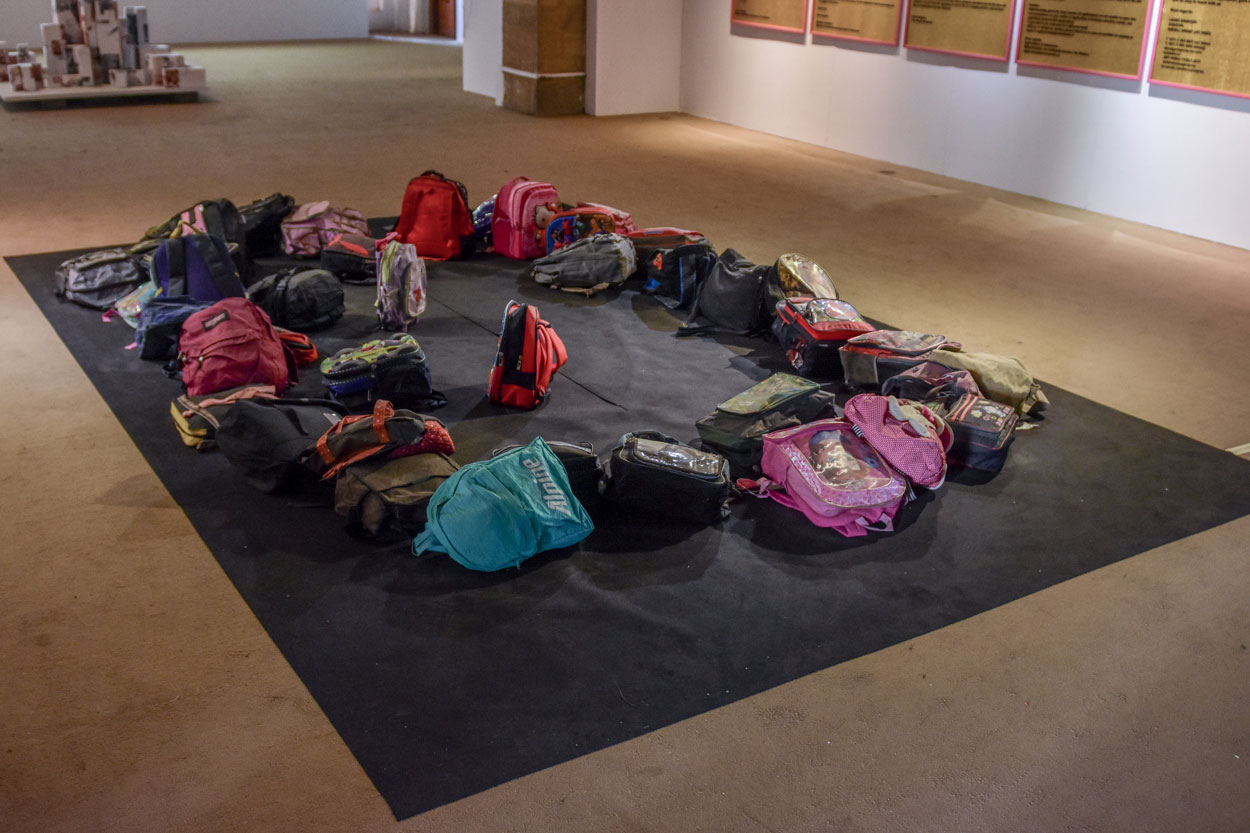
Absent/Present, 2017.
Sound installation, school bags, sensors and speakers
Dimensions variable
Jean Hubert
Born in 1987 in Ivry-sur-Seine (France)
Lives and works between Paris (France) and Amsterdam (The Netherlands)
Jean Hubert graduated in 2010 from the Ecole Nationale Supérieure des Beaux-Arts de Paris (Ensba). During his coursework, he also studied video for one year at the Emily Carr University in Vancouver. He has participated in several exhibitions in France and abroad, notably, “Visio Schermo del Arte,” (Teatro la Compania, Florence, 2016); “The Time I Spent Going Nowhere,” (Billytown, La Haye, 2016); “Personal Science Solution Is For Me,” (Momart, Amsterdam, 2015); “The Script Inside Me Ep- 01,” (Fondation BilbaoArte, Bilbao, 2014); “The Great Indoors” (Motive Gallery, Brussels, 2013); The Rijksakademie Open (Amsterdam, 2012&2013); and the Salon de Montrouge, Paris (2012). In 2016 he had two solo shows, one in Hector, Mexico DFE, “Panorama Jean Hubert,” and the other in la Petite Galerie. As a starting point for Hubert’s film works, there is no plot. There is only an element of speech extracted from reality—i.e., text messages, hijacked phone conversations, lists of proverbs—to which the artist wants to give a second resonance from real life through the form of film. In order to do so, he establishes a protocol, or an ersatz protocol, working with actors, filmed rehearsals, the excavation of a hidden document, a political meeting, etc. This action procedure undoes itself as the film goes along and becomes essentially a visual procedure, that is to say a re-appropriation of a film genre (spy film, love story, propaganda clip.) Through this process Hubert explores the initial material that sparked the film.
In Waiting for Sleep, Hubert investigates the form of a diary through computer-generated animation. Grounding the work in the fantasy genre, he creates an animated film which recounts the daily life of a character, Will, who is a sleepwalker surrounded by zombies. Will narrates this tale via text messages and phone conversations. (“1:33 – I'll save you. 3:49 – How is dad? 3:51 - How are you? It's okay. I take care of everything. How's dad? 3:58 – Good. Good. 4:01 – Yes I am careful, I am very careful,” etc.) This mundane dialogue takes an opposite direction to the action. Hubert’s characters, often in a state of doubting, recount a fictive world other than the one they inhabit. That other world is our reality. They speak of our daily worries, our banal tasks through this window opened by fiction.

Still from Waiting for Sleep - Part One, 2016.
Video HD, 6:50 min.
This work was supported by the Amsterdams Fonds voor de Kunst and by the Aide individuelle à la création de la Drac Ile-de-France
The presence of this artwork was made possible by French liaison Abi Tariq, with support from Cité Internationale des Arts, Paris
Faisal Anwar
Born in 1970 in Murree (Pakistan)
Lives and works in Toronto (Canada)
Faisal Anwar, a new-media artist based out of Toronto, works locally and across the world. A graduate of the Canadian Film Centre’s Habitat-LAB, Anwar was earlier trained in graphic design at the National College of Arts, Lahore. Amongst his numerous international exhibitions, some of the significant ones include Winter Olympics Vancouver, 2010; the Aga Khan Museum, Toronto, 2016; Nuit-Blanche art festivals in Toronto and New York, 2011, 2015, and 2016; Six Degrees of Separation exhibition in India, Pakistan and Bangladesh, 2008. His project Tweetgarden was showcased at the Royal Ontario Museum in 2012. Several of Anwar's short films have been featured in festivals in Canada and abroad. Passionate about innovating within the scope of contemporary Art and hybrid design, Anwar’s art practice is about creating odd configurations integrating culture and technology. He explores social interactivity and collective behavior in modern urban cultures by tapping into people's perceptions of public and private spaces. To examine and express his insights about ideas of identity, pains of dislocation, and notions of power, Anwar's medium of art is data, social media, and recently Augmented realities. He investigates sociocultural alienation resulting from “globalization,” impacting every aspect of life and forming myriad homogenized visual similarities between world cities. Most of Anwar’s projects are participatory in nature inviting his audience to interact and evolve.
Faisal Anwar’s commissioned work for KB17 emanated from a workshop he conducted earlier in the year at the NJV in which he asked students of the school to map their city using cell phone photography. He writes of the project: “I See my Streets/I See Karachi is a new-media installation driven by youth and community participation. A population of over 24 million people with a remarkable 80% expansion over the past decade, Karachi is the world’s fastest-growing megacity. Her streets are a chaos of movement– people, traffic, graffiti, landmarks, and a dense network of colonial, modern, and makeshift architecture and spaces. My interest is in creating a new form of visually rich, image-centric, street views capturing hidden patterns of flow–no maps or numbers, only contemporary social networks will be used.”
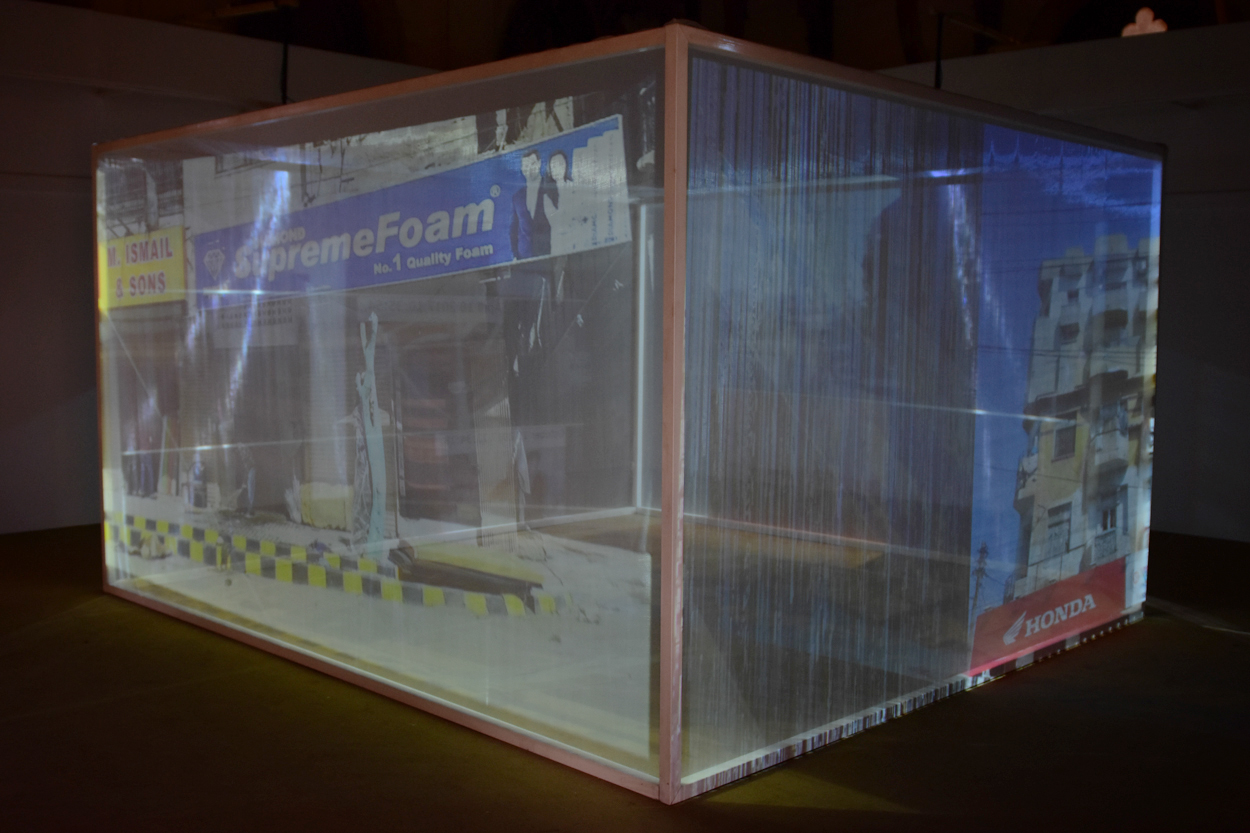
I See my Streets/I See Karachi, 2017.
Participatory interactive Installation, video projections, social media interaction
457 cm. cube
Courtesy the artist
(LA) HORDE
Founded 2013
(LA) HORDE is a collective of three French artists: Marine Brutti (b. 1985), Jonathan Debrouwer (b. 1985) and Arthur Harel (b. 1991). Together, they develop their practice through stage direction, filmmaking, video installation, choreography and performance. After creating a choreographic piece for Seniors (Void Island) and another one for future graduates of ECDMTL (Avant les gens mouraient) in 2014, the artists were invited to create a film and performance at the International Biennale of Design in Saint Etienne, France. This film, Novaciéries (2015), has been projected at the Centre Pompidou, IFFR, Slamdance and Clermont-Ferrand. In 2016, (LA) HORDE created a new show on Hard-Dances titled TO DA BONE, which won second prize at Danse Élargie at the Théâtre de la Ville in Paris. The show had its premiere at the FTA festival in Montreal in 2017. Between 2016 and 2017, (LA) HORDE was commissioned to make a number of videos, including Larger Than Life in 2016 and Cloud Chasers for the Fondation d'entreprise Lafayette in 2017. The collective’s leitmotiv is to question and swap the codes of different artistic scenes for contemporary art and living art.
Larger than Life is the result of a four hour-long performance. The artists chose to drag out the length of production to suggest an intimate gathering that lasts several hours. Taking the idea of a family reunion as a point of departure, (LA) HORDE created a minimalist setting of a dinner table. As this dance-based video opens, men and women are seen gathered around the table. One by one, they gather on top of the table and begin to dance, directly engaging the viewer by approaching the camera and staring into it, seemingly energized by this outside engagement. Further exploiting the idea of voyeurism, (LA) HORDE included those watching the production of the video in the video itself: The audience was both assisting the video and participating in it. Throughout this time, the participants move both in unison and alone, producing a continuous movement in which the body can again and again reinvent itself. As the video ends, the table is folded up and taken away; the dancers are left frozen in place and seemingly together, but in their own thoughts. By using “datamoshing” during the editing process, the collective superimposed new designs, shapes and imagery upon existing ones in order to emphasize the concept of fluidity.

Still from Larger Than Life, 2016.
Video, 5:55 min.
Courtesy the artists
The presence of this artwork was made possible by French liaison Abi Tariq, with support from Cité Internationale des Arts, Paris
Wajid Ali
Born in 1981 in Daharki (Pakistan)
Lives and works in Gujrat (Pakistan)
Wajid Ali obtained his MA (Hons.) in Visual Art from the National College of Arts, Lahore, in 2010, after receiving his BFA (Hons.) from the University of Karachi in 2004. His work has been exhibited widely both nationally and internationally. He has been a key member of important artistic projects, including: the ‘W11 – Karachi to Melbourne Project’ for the 2006 Commonwealth Games in Melbourne; and ‘The Great Wall of Pakistani Truck Art Project at the new Islamabad Airport, in 2017. He has conducted several art workshops and seminars at various institutions, such as: University of Gujrat; Mirpur University, Azad Kashmir; Hazara University, Manshera, KPK, and has worked with the craftsmen of Hunza and Attabad in Gilgit-Baltistan. Ali’s artistic practice derives from his passion from land travel, roaming the diverse regions of Pakistan in buses, trains, trucks and automobiles, taking the viewer on a virtual voyage through his experiences. These experiences have led the artist to discover and immerse himself in new cultures and their modes of expression, establishing a novel, tripartite dialogue between the audience, Ali’s personal journeys and the places to which he has travelled.
Ali’s work for the Karachi Biennale 2017 is a series of lightboxes; artistic travelogues depicting his wanderings from January 2014 to December 2016. The concept of an artistic travelogue has been a long-term project for Ali, having developed it in 2009, with the artist marking his journeys in a diary on a daily basis ever since. The grand scale of the 36 lightboxes appropriately highlights the abstract complexity of the intersecting web of the 1095 drawings, with each of the three rows of twelve drawings representing a calendar year. Ali describes his project: “Through lines and mark-making I have recreated journeys that have been taken by me over several years, on paths trodden a hundred times or sometimes only once. The continuity of the lines reflects time and space, taking the viewer on a trip through my personal experiences.”

Journeys Taken 2014-2016 (Installation of 1095 Drawings), 2017.
Valchromat, transparency films, pen, acrylic sheet, SMD backlit
23 x 1097 x 9 cm.
Courtesy the artist
Nahid Raza
Born in 1948 in Delhi (India)
Lives and works in Karachi (Pakistan)
Nahid Raza hails from a family with distinguished art connections. Her late father, Syed Yusuf Raza, was a journalist, art writer and the author of a book on economics. Her life in art began in 1966 when her uncle Ali Imam helped her to join the Central Institute. Later, in 1968 she held her first group exhibition while she was still a student. In 1969, she won her first award, the ‘Best Entry Award’ at the Karachi Arts Council. She was deeply inspired by the intricate stone carvings of Sindh which resulted in her first major landmark works on the Chawkandi Tombs. Soon, the mounting appreciation of her work abroad led to solo exhibitions in Japan, Bangladesh and India. On her return to Karachi, in 1987, she began teaching art full-time. In 1992, Nahid established Studio Art in Karachi, and for over a decade, nurtured several promising talents. She was awarded a residency at the New York State University in 1998. In 2002, her work was displayed in a solo exhibition at the Vienna Museum. Nahid has visited several countries across the globe for her solo and group exhibitions. These include Bezirk Museum, Vienna; Asian Art Biennial, Bangladesh; SAARC exhibition in New Delhi, and a group show called "Intelligent Rebellion" by Pakistani women artists in Bradford, England. In August 2007, Nahid was awarded the President’s Pride of Performance Award, the highest art honor in the country.
For KB17, Nahid Raza has created a major painting from her ongoing Virdh series. The word “virdh” refers to repetition of a certain incantation – a practice that exists in many religions. Nahid’s recent work revolves around motifs that have been repeatedly screen-printed on large canvases. Nahid believes there are spiritual ways to purge inner frustrations and to shed agony. One such way is the practice of Sufism, which inculcates divine ethics through devotion towards the Almighty. As a strong believer in divine realities, she has emphasized that there is spirituality in every person. She expresses the feelings that virdh creates in her soul through painting. It is her intention to depict serenity and peace in her canvases.

Virdh Series, 2017 (Detail)
Acrylic on canvas
640 x 457 cm.
Courtesy the artist
Sharmeen Obaid Chinoy
Born in 1978 in Karachi (Pakistan)
Lives and works in Karachi (Pakistan)
Sharmeen Obaid Chinoy is a two-time Academy Award and Emmy Award winning documentary filmmaker. In the past 16 years, she has made a dozen multi-award winning films in over 10 countries around the world. Her films include Girl in the River, Song of Lahore, Saving Face, Peace Keepers, Transgenders: Pakistan’s Open Secret and Pakistan’s Taliban Generation. Her work has aired on channels spanning four continents including HBO, CNN, PBS, Channel 4, CBC, Arte, SBS and the Discovery channel. In 2012, Time Magazine included Sharmeen in their annual list of the 100 most influential people in the world. That same year the Pakistan Government awarded her with highest civil honor “Hilal -e–Imtiaz”. In 2013, the Canadian government awarded her a Queen Elizabeth II Diamond Jubilee Medal for her work in the field of documentary films and the World Economic Forum honoured her with a Crystal Award at their annual summit in Davos. In 2017, Sharmeen was the first artist ever to co-chair the “World Economic Forum” at Davos. Born and raised in Karachi, Pakistan, Sharmeen received a Bachelor’s degree from Smith College and two Masters’ degrees from Stanford University.
Sharmeen Obaid has submitted five VR films for KB17. Virtual Reality (VR) technology is the computer generated simulation of the three-dimensional that can be interacted with in seemingly real and physical ways via specialized electronic equipment such as goggles and helmets fitted with sensors. With the launch of its newest project, Look but with Love, SOC Films is the first to bring VR technology to Pakistan. Look but with Love is a series of short films designed to promote the rich cultural history of Pakistan, champion the empowerment of women and children and evoke a sense of social responsibility and consciousness. With VR technology at their center, the films will have an immediate and sensory effect on the audience, challenging them to observe and, most importantly, question the world around them. Through these films, the audience will be exposed to the rich musical history of Sindh’s Jamshoro, the women fighters of KPK’s Nowshera, the plight of sick children in Karachi hospitals and the beautiful and often unexplored deserts of Thar.
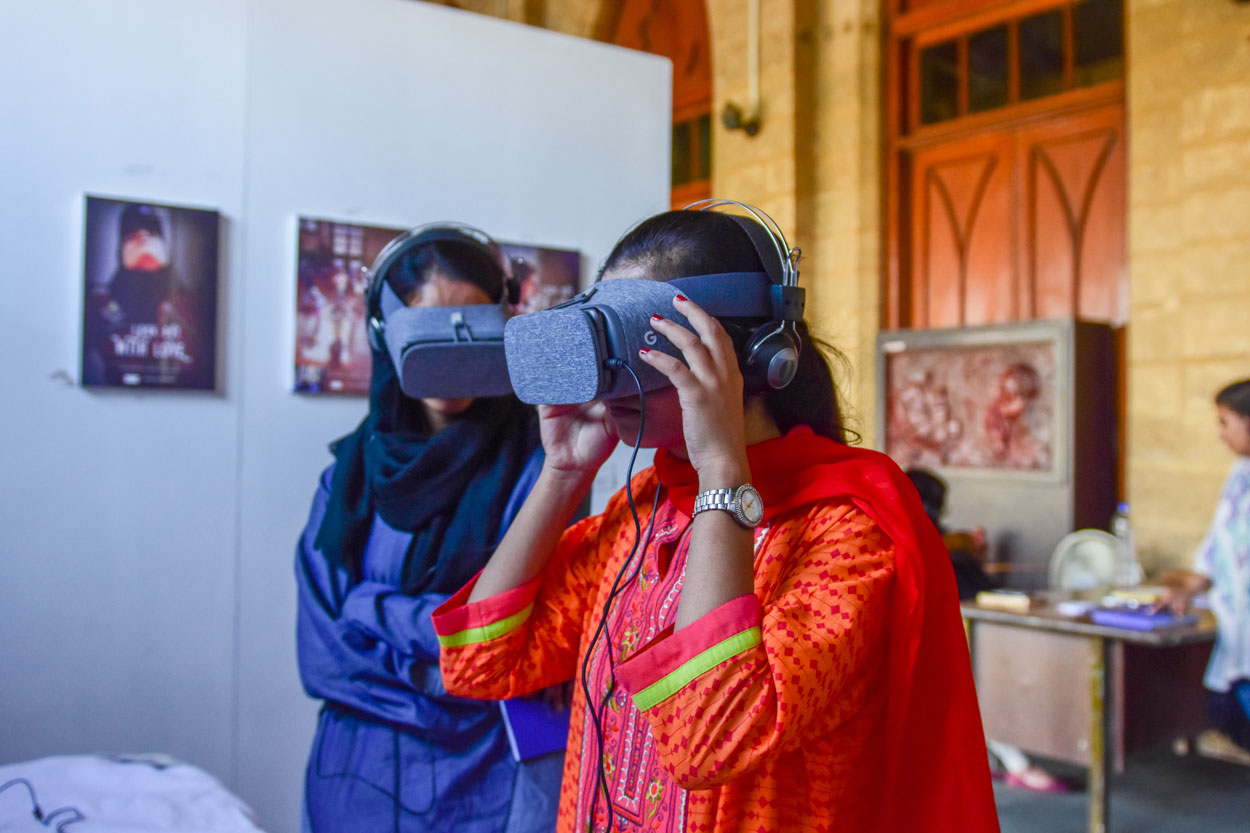
Look but with Love, 2017.
Five VR Films, 2k. Sphere 360, plays on mobile phones with a headset
Produced by SOC Films in collaboration with WITHIN & HERE BE DRAGONS
Umberto Zampini
Born in 1958 in Occhiobello (Italy)
Lives and works in Venice (Italy)
Umberto Zampini is an artist, photographer, curator, publisher, clandestine traveler and Venetian. He has lived many years in various Italian, European and US locations. Before returning to Venice a few years ago, he lived among wolves and wild boars on top of a hill between Modena and Bologna. He travels incessantly, photographing, through the Po Valley, avoiding crossing the Ticino River. He first published his photographs in the magazine AD Italy in 1983.
Umberto Zampini has on view at KB17 work from two of his series of photographs: Shift on a Plain (2016) and A Mile Around (2014). The first comprises photographs taken from a train window. He writes: “Space designed by movement, signs that remain impressed in the traveler's memory. Those for whom the destination does not count, but whose final aim is the actual journey. The underlying interest is in the clear and distant time-spaces, and the sudden elusive and confused nearby apparitions within them. The calligraphies of speed hence provide new insightful perceptions into the apparent immobility of the plain where my grandparents lived…These photographs have been voluntarily printed on poster paper to maintain their window-like nature onto the world. They are two dimensional, almost immaterial openings in the walls that always surround us. Through them appear sudden trees, dusk, disappearing fields swallowed by the fast pace of our lives.” The second series comprises black-and-white photographs placed within small black boxes. The photographs were taken within a one-mile radius of the gallery in Modena, Italy where they were later exhibited. Zampini writes: “Modena is a sunny and cheerful city where life is enjoyable. I dug deep into her inner fears: and a darker city was drawn through my lens and came to life. People did not recognize the roads they had walked to come visit the exhibition. They did not know where the photos were taken; almost fearing to recognize their beloved city. I'm not a photo reporter: I use photography to paint what the eye does not see; the mind’s eye.”
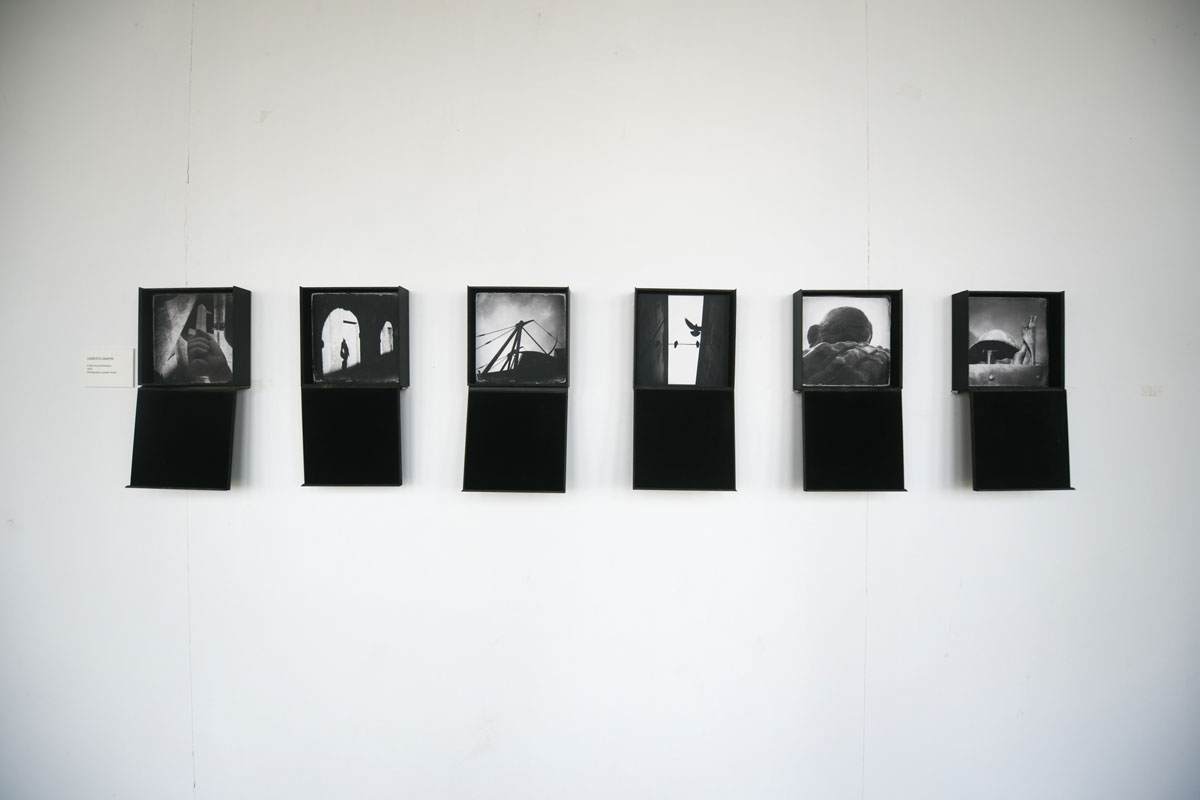
A Mile Around Modena, 2014.
Photographs, wooden boxes
Stephen Sheehan
Born in 1986 in Birkenhead (UK)
Lives and works in Birkenhead (UK)
Stephen Sheehan graduated from Wirral Metropolitan College obtaining a first class honours degree in Fine Art in 2014. In 2016, he obtained an MA in Fine Art at John Moores University at Distinction Level. During his MA, Sheehan was nominated and selected as a Liverpool Biennial Associate Artist, a two-year programme that aims to support and develop the career of northern artists on an international level. Sheehan predominately works with film, performance and video. He has a particular interest in exploring human mortality and repetition.
Sheehan has submitted two videos for the 2017 Karachi Biennale. The first, Parrot Reflection, is a film he created during a one-month residency at ALN in Albany, New York, USA in 2016. Parrot Reflection depicts the moment when a character wearing a hat (played by Sheehan) discovers his reflection in a mirror that he finds in the snow. The film then proceeds to capture various characters as they find themselves in questioning conversations with their own physical reflections within an absurd world. Sheehan used Averill Park, a hamlet in rural New York, as a backdrop for the film while blending real life situations with filmed performances, allowing both fantasy and reality to merge. The work comments upon existence, morality and the self. The second video, titled Cambrian Explosion: I Arrived at the Circus at Two Minutes Past Eight, is a new film created specifically for KB17 during a one-month residency in Karachi with Vasl Artists’ Association. Making reference to the brief of Sight, Sheehan refers back to the Cambrian Explosion as a foundation for the film. The Cambrian Explosion was a period in time when sight first developed allowing life to flourish. Sheehan transforms and places the Cambrian Explosion into modern day society while exploring and presenting the absurd, beautiful, fragile and transient existence we find ourselves in. Stephen Sheehan will also be doing a performative work for the Karachi Biennale 2017.

Still from Parrot Reflection, 2016.
Single channelled video, 14:22 min.
Courtesy the artist
Agha Abbas
Born in 1969 in Karachi (Pakistan)
Lives and works in Karachi (Pakistan)
Agha Abbas has been in the media industry for the past 20 years and has extensive experience in Photography and Video Production. He writes: “When I started out there were no non-linear editing machines or LCD monitors on cameras and the closest thing one had to a portable flash drive was a 1.44Mb floppy disk. The technology has come a long way since. My love for the camera (and art in general), is not far from what should have been expected. My (Late) father, Agha Sadaruddin (RIP), was a Time and Life photographer, a documentary filmmaker par excellence and younger brother to the legendary Gulgee. My earliest memory is that of begging my father to let me agitate this tray filled with some ‘magic water’ (developer), in which dipping a plain piece of paper (after being exposed to a projected image from an Enlarger), resulted in an Image emerging on it. Sheer magic it was! It must have been such encounters that got me to fall for the art of photography at a very early age.”
In his photographs for KB17, Agha Abbas calls forth multiple, layered stories of an industrialized landscape. Architecture is more than buildings alone. It is also the shadows they cast on the ground and on structures surrounding them, the ambient lights that play off their facades and windows, the scaffoldings and piles of discarded rebar that have yet to be removed from their building sites. It is the stories, mostly unheard, of the labourers who rise at dawn, travelling long distances to toil.

Untitled, 2017.
Digital photograph
81 x 122 cm.
Courtesy the artist
Syed Jamal Shah
Born in 1956 in Quetta (Pakistan)
Lives and works in Islamabad (Pakistan)
Syed Jamal Shah is an artist, writer, filmmaker, educationist and social worker. He completed his Master’s in English literature from Balochistan University and joined the National College of Arts, Lahore, where he was the first to major in Sculpture. Upon completing his degree there, Shah returned to Quetta, where he set up the Department of Fine Arts at Balochistan University. He chaired the department for three years and then went on a British Council scholarship to do a Master’s in printmaking from The Slade School of Arts, London. Trained in various disciplines of Visual Arts, his forte remains sculpture. He has been a prolific artist throughout his career and has exhibited widely in Pakistan and internationally. He is the recipient of many awards including the Gold Medal at the 5th Asian Art Biennale in Dhaka. His work is part of the permanent collections of the Victoria and Albert Museum, London and Fukouka Museum, Japan. He has done many important commissioned projects in Pakistan and abroad. In addition, Shah founded the Hunerkada Art Academy in Islamabad and has been Director General of the Pakistan National Council of the Arts.
For KB17, Syed Jamal Shah has created a 25-foot metallic cage with wings surrounded by a number of life-size human figures cast in various materials and installed at Frere Hall, a central Karachi location. The surfaces of the sculptures have been treated in a variety of media. The installation also includes: two large LED screens for video projection of performances; a poetry recital by renowned media personalities/actors; dance by Amna Mawaz and the NPAG group of PNCA; music by Sain Khawar and Ustad Hamid Shahid and Faqirs from Sindh; as well as live painting and graffiti during the dance performances. The work invites a cross-disciplinary interactivity and engages other important artists from different disciplines including students and art enthusiasts in performances that will simultaneously be video recorded and projected. Syed Jamal Shah writes, “SITUATION 101 is a major art project specially executed for Karachi Biennale 2017 with the thematic area witness in mind. The work is a playful comment on the dichotomy of freedom, un-freedom Inviting interactivity, questions and interpretations. Being based on the eternal paradox of the cage within, invisible cage or the relativity of freedom and free will, the project wishes to initiate a dialogue on several levels. At one level It is about subjugation, submission and dehumanization; on others it reflects hope, dreams and the human struggle for liberation and situations in life that might have encouraged human beings to engage with life intimately in a creative and critical manner thereby triggering evolution and change. It is also about the inborn need of humankind to connect despite ironies, absurdities and playfulness from ancient history to living cultures with esthetic crossovers. SITUATION 101 as an art activity also questions the essence of art as a vehicle for change and esthetic decision-making. It is as much about the function of art as it is about the art object which is why it presents itself to be a non-museum work that seeks spontaneous interaction with people.”
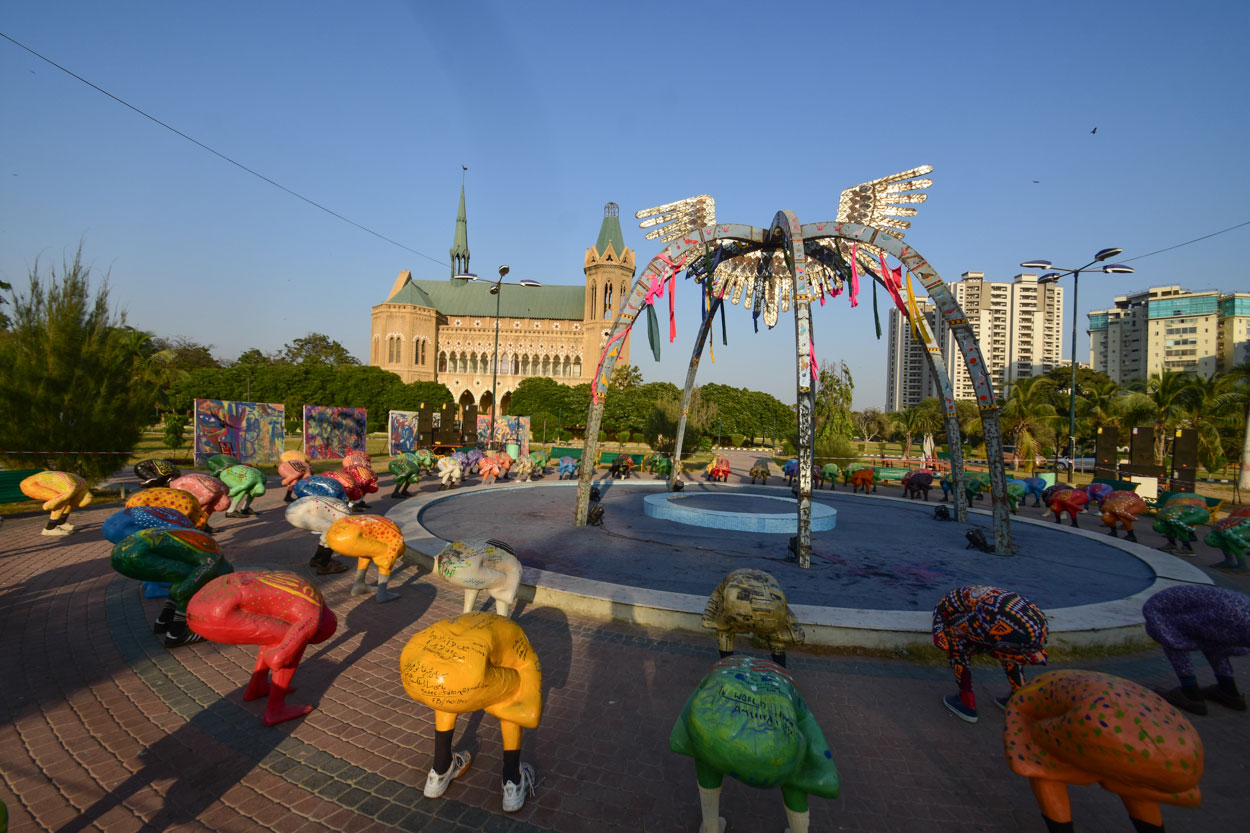
SITUATION 101, 2017.
Sight-specific project of sculptural Installation involving 101 sculptures, performance, poetry, music and video projections
Muhammad Zeeshan
Born in 1980 in Mirpurkhas (Pakistan)
Livers and works in Karachi (Pakistan)
Muhammad Zeeshan started working from a very young age as a cinema board painter in his hometown of Mirpurkhas in Sindh province. In 2000, he gained admission to the the National College of Arts, Lahore, where he graduated in 2003 with a Bachelor’s degree in Miniature painting. He has exhibited widely both in Pakistan and abroad. His work is in the collection of the Metropolitan Museum of Art, New York, among other institutions.
Muhammad Zeeshan writes of his submission for KB17: “It’s the worst fear of all. The seed of acute despair. But for me, ‘Failure’ has always been a great vision. It has allowed me to grow and gain motivation to resolve the challenge of the unfinished, the unsolved, the mysterious. This project is based on a selection of rejection letters sent to me by various organizations.”

Sincerely Yours, 2017.
Reflective sticker on cloth encased in acrylic sheet.
Eight works 120 x 91 cm each
Courtesy the artist
Sonia Khurana
Born in 1968 in Saharanpur (India)
Lives and works in New Delhi (India)
Sonia Khurana works with lens based media, moving image, performance, text, drawing, sound, and installation. Often using the performative mode, she structures the self through states of strangeness, alienation, displacement, interiority and embodiment. Placing the body in an oblique relation to diffused feminist aesthetics of the counter-spectacle and performative resistance, she strives to engage with the constant negotiations between body and language, the self and the world. Through these deliberately poetic intimations, she tries to persistently explore and re-define the space of the political. Sonia Khurana studied art in London at the Royal College of Art, where she completed her Masters in 1999, and earlier in Delhi, at the Delhi College of Art. In 2002, Sonia did a two-year Residency Programme for practice-based research at the Rijksakademie VBK in Amsterdam. Her works have been shown and collected internationally. Group shows include: Exhibitions elles@Centre Pompidou (2009/2010), Global Feminisms, Brooklyn Museum (2007), the Aichi Triennale [2010], the Gwangju Biennale [2008], West Heavens [2010], Sculpture Motion, Wanas Konst, Sweden [May to Nov 2017] Her solo expositions, include: “Lone Women Don’t Lie,” (2000), “Many Lives” (2006), “Still/Moving Image (2007), “Living in the Round,” (2009), “Oneiric House: Round About Midnight” (2014) and most recently, “Fold/Unfold” (2017).
Sonia Khurana writes of her video film installation on view at KB17: “The World is a series of images and text, poetic meanderings on the theme of home, homelessness and living between places; my own poetic meanderings on the theme often resonate with other, existing thoughts and texts and experiences, most of all those of my grandmother’s.”

I’m Tied to My Mother’s Womb with A Very Long Chord, 1998.
Two channel video installation
Color, silent. 5:00 min. looped. Hi-8 transferred to SD.














